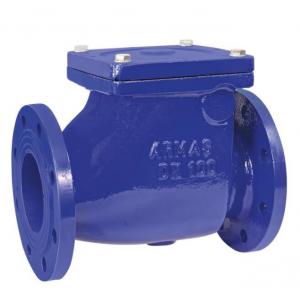

Add to Cart
DN100 API600/API 6D Cast Steel Check Valve flange end wafer swing check valve
The pressure of the fluid passing through a system opens the valve,
while any reversal of flow will close the valve. Exact operation
will vary depending on the type of Check valve mechanism. Most
common types of Check valves are swing, lift (piston and ball),
butterfly, stop and tilting-disk.
Specifications:
| Nominal pressue (MPa) | 1.0 | 1.6 | |
| Nominal diameter(mm) | 50-600 | 50-600 | |
| Test pressure | Shell | 1.5 | 2.4 |
| (MPa) | Seal | 1.1 | 1.76 |
| Applicable temperature | 150 | ||
| Applicable medium | Fresh water, Sewage, Sea water, Air, Vapor, Food, Medicine, Oils,
Acids, Alkalis, etc. | ||
| Operating mode | manual, worm gear, pneumatic, electric, etc. | ||
Standards:
| Design & Manufacture | Flange Connection | Face to Face Dimension | Test & Inspection |
| DIN3202 | DIN2533&EN1092 | DIN3202 F6 |
Swing Check valve
A basic swing Check valve consists of a valve body, a bonnet, and a
disk that is connected to a hinge. The disk swings away from the
valve-seat to allow flow in the forward direction, and returns to
valve-seat when upstream flow is stopped, to prevent backflow.
The disc in a swing type Check valve is unguided as it fully opens
or closes. There are many disk and seat designs available, in order
to meet the requirements of different applications. The valve
allows full, unobstructed flow and automatically closes as pressure
decreases. These valves are fully closed when flow reaches zero, in
order to prevent backflow. Turbulence and pressure drop in the
valve are very low.
Lift Check valve
The seat design of a lift-Check valve is similar to a Globe valve.
The disc is usually in the form of a piston or a ball.
Lift Check valves are particularly suitable for high-pressure
service where velocity of flow is high. In lift Check valves, the
disc is precisely guided and fits perfectly into the dashpot. Lift
Check valves are suitable for installation in horizontal or
vertical pipe-lines with upward flow.
Flow to lift Check valves must always enter below the seat. As the
flow enters, the piston or ball is raised within guides from the
seat by the pressure of the upward flow. When the flow stops or
reverses, the piston or ball is forced onto the seat of the valve
by both the backflow and gravity.
Features:
1. Small in size, light in weight, compact in structure,easy in
maintenance.
2. Two torsion springs are used excreting on each of the pair valve
plates,which close the plates quickly
And automatically.
3. The quick-close action prevents the medium from flowing back and
eliminates water hammer effect.
4. Short body structure length and good rigidity.
5. This valve is tightly sealed, without leakage under the pressure
water test.
6. Safe and reliable in operation,high interference-resistance.
